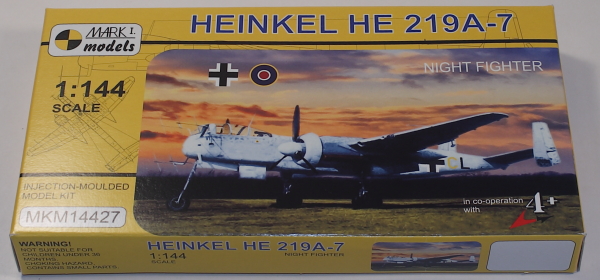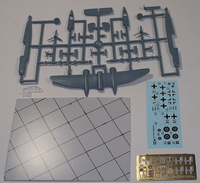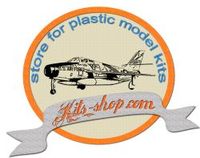
Mark I 1/144 He 219A-7 Night Fighter
By Matt Bittner
Introduction
The Heinkel He 219 was known as the “Uhu” which is German for Eagle-Owl. It was developed as a night fighter right from the start and it incorporated a number of unique designs, including its sophisticated radar. For better information on the He 219 the best sources are both from Valiant Wings. First is their Airframe Album and lastly is their book on building the 1/32 Zoukei-Mura kit. Sure, wrong scale for this article, but the book contains details that can be used in any scale, including 1/144.
The Kit
The Mark I He 219A-7 consists of 34 gray, injected plastic pieces, one clear canopy, a photoetch fret with 37 pieces and a card-stock, pre-printed base. There are decals – nicely printed and appear to be in register – for four aircraft:
- W.Nr 310193, Luftwaffe, Germany, spring 1945
- Black/Red G9+SK, 2/NJG.1, Luftwaffe, Munster-Handorf Air Base, Germany, spring 1945
- Black/Yellow D5+CL, 3/NJG.3, Luftwaffe, Grove Air Base, Denmark, April 1945
- Air Ministry 22, Royal Aircraft Establishment, Farnborough, England, 1945-46
All four aircraft are Light Blue-Grey RLM 76 overall with Grey RLM 75 mottling on the upper surfaces.
 As with most aircraft models construction starts with the cockpit. It consists of injected plastic and photoetch pieces and results in a decent cockpit if keeping the canopy closed. If you want to add more detail, this is where the Valiant Wings book on building the 1/32 kit would come in handy.
As with most aircraft models construction starts with the cockpit. It consists of injected plastic and photoetch pieces and results in a decent cockpit if keeping the canopy closed. If you want to add more detail, this is where the Valiant Wings book on building the 1/32 kit would come in handy.
Once the cockpit is in and the fuselage halves assembled then construction continues to create an entire airframe. Wings, nacelles, tail surfaces, everything to make a complete aircraft. One thing to keep in mind is it’s going to take a fair amount of weight to ensure the model sits on its nose-gear. Since the cockpit is right over the nose landing gear, you’ll need to add weight to other areas. Behind the cockpit and in the engine nacelles are two places. Or, and I suspect it’s why it’s included, you can glue the model to the card-stock base provided. In fact, it’s mentioned on the instruction sheet for one of the ways to keep the model sitting on its gear correctly.
There are a lot of exterior photoetch pieces, most best left off until the end. Especially the nose radar antenna. There is no doubt in my mind these will be knocked off if you place them on before painting and decaling.
Conclusion
This is an excellent kit, really well molded and will look great when finished. My plans on painting it will be to find a small sponge or brush to apply the mottling after applying the RLM 75. I can’t really see any other way to do it in 1/144. But don’t let this dissuade you from picking up this model. The Mark I He 219s (and there are three different boxings) is an excellent example of what’s possible in 1/144.
My thanks to Kits-Shop for supplying the review kit.

